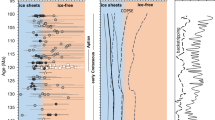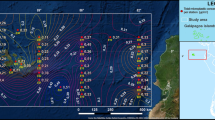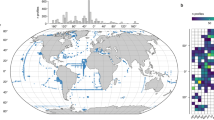Abstract
Ocean floor spreading centres described recently consist of several sites with chemical and biological features unlike any oceanic sites previously known1–4. The high-pressure and warm-temperature regimes at these sites, coupled with dynamic hydrothermal water circulation, support biological communities that utilize a source of primary production which appears to be non-photosynthetic5. A detailed biochemical analysis of the suspended matter at a biologically-active site has been undertaken, with the goal of describing the relationship between microorganisms, benthic organisms and suspended particulate material within these hydrothermal systems. Suspended particulate matter from warm hydrothermal vent waters (5–38°C) of the East Pacific Rise1–4 (21° N, 106° W) was sampled on the OASIS expedition with an in situ pumping system in April 1982. Particulate organic carbon (POC) and nitrogen (PON) as well as individual organic compound classes from the lipid fraction were analysed to ascertain the sources and composition of the organic matter in this highly productive area. We show here that the particulate organic material (POM) of the vent water was both quantitatively and qualitatively different from the non-vent bottom water. The POC and PON measured within the vent and non-vent waters vary by a factor of 2–5, the higher values being in warm water. The organic matter in the non-vent water was found to be more resistant towards degradation or remineralization than in the vent water, as shown by the C:N ratio and the total lipid:POC ratio. Contributions to the lipid class compounds were assessed using well-known organic compound source biomarkers such as hydrocarbons, fatty alcohols, sterols, triacylglycerols and steryl and wax esters.
This is a preview of subscription content, access via your institution
Access options
Subscribe to this journal
Receive 51 print issues and online access
$199.00 per year
only $3.90 per issue
Buy this article
- Purchase on Springer Link
- Instant access to full article PDF
Prices may be subject to local taxes which are calculated during checkout
Similar content being viewed by others
References
Edmond, J. M. Nature 290, 87–88 (1981).
Ballard, R. D., Francheteau, J., Juteau, T., Rangan, C. & Normark, W. Earth planet. Sci Lett. 55, 1–10 (1981).
CYAMEX Scientific Team, Nature 277, 523–528 (1979).
Rise Project Group Science 207, 1421–1433 (1980).
Karl, D. M., Wirsen, C. O. & Jannasch, H. W. Science 207, 1345–1347 (1980).
Gelman Sciences Laboratory Filtration Catalog PB-600, 21 (1982).
Peltzer, E. T., Alford, J. B. & Gagosian, R. B. Sampling, Preparation, and Quantitative Identification of Lipids in Remote Marine Aerosols (Woods Hole Ocean.Inst. Tech. Rep., in the press).
Blumer, M. Analyt. Chem. 29, 1039–1041 (1957).
Gagosian, R. B. & Nigrelli, G. E. Limnol. Oceanogr. 24, 838–849 (1979).
Wangersky, P. J. Deep-Sea Res. 23, 457–465 (1976).
Williams, P. M., Carlucci, A. F. & Olson, R. Oceanol. Acta 3, 471–476 (1980).
Gagosian, R. B., Loder, T., Nigrelli, G. & Love, J. Woods Hole Oceanogr. Inst. Tech. Rep. 83–5 (1983).
Parsons, T. R. in Chemical Oceanography Vol. 2, 365–383 (Academic, New York, 1976).
Fleminger, A. Proc. Biol. Soc. Wash. (in the press).
Farrington, J. W. & Meyers, P. A. in Environmental Chemistry Vol. 1 (ed. Eglinton, G.) 109–136 (The Universities Press, Belfast, 1975).
Simoneit, B. R. T. & Lonsdale, P. F. Nature 295, 198–202 (1982).
Forster, H. J., Biemann, K., Tattrie, N. H. & Colvin, J. R. Biochem. J. 135, 133–143 (1973).
Brassell, S. C., Wardroper, A. M. K., Thompson, I. D., Maxwell, J. R. & Eglinton, G. Nature 290, 693–696 (1981).
Gagosian, R. B. & Farrington, J. W. Geochim. cosmochim. Acta 42, 1091–1101 (1978).
Sargent, J. R., Lee, R. F. & Nevenzel, J. C. in Chemistry and Biochemistry of Plant Waxes (ed. Kolattukudy, P. E.) 50–93 (Elsevier, New York, 1976).
Wakeham, S. G. Geochim. cosmochim. Acta 46, 2239–2257 (1982).
Gagosian, R. B. Geochim. cosmochim. Acta 39, 1443–1454 (1975).
Nes, W. R. & McKean, M. L. Biochemistry of Steroids and Other Isopentenoids Ch. 10 (University Park Press, Baltimore, 1977).
Idler, D. R., Khalil, M. W., Brooks, C. J. W., Edmonds, C. G. & Gilbert, J. D. Comp. Biochem. Physiol. 59B, 163–167 (1978).
Williams, P. M., Smith, K. L., Druffel, E. M. & Linick, T. W. Nature 292, 448–449 (1981).
Comita, P. B. & Gagosian, R. B. Science 222, 1329–1331 (1983).
Author information
Authors and Affiliations
Rights and permissions
About this article
Cite this article
Comita, P., Gagosian, R. & Williams, P. Suspended particulate organic material from hydrothermal vent waters at 21° N. Nature 307, 450–453 (1984). https://doi.org/10.1038/307450a0
Received:
Accepted:
Issue Date:
DOI: https://doi.org/10.1038/307450a0
This article is cited by
-
Chemosynthetic origin of 14C-depleted dissolved organic matter in a ridge-flank hydrothermal system
Nature Geoscience (2011)
-
Formation of Zn- and Fe-sulfides near hydrothermal vents at the Eastern Lau Spreading Center: implications for sulfide bioavailability to chemoautotrophs
Geochemical Transactions (2008)
-
Survival and growth of two heterotrophic hydrothermal vent archaea, Pyrococcus strain GB-D and Thermococcus fumicolans, under low pH and high sulfide concentrations in combination with high temperature and pressure regimes
Extremophiles (2007)
-
Transparent exopolymer particles in a deep-sea hydrothermal system: Guaymas Basin, Gulf of California
Marine Biology (2007)
-
Particulate materials and microbial assemblages around the Izena black smoking vent in the Okinawa trough
Journal of Oceanography (1993)
Comments
By submitting a comment you agree to abide by our Terms and Community Guidelines. If you find something abusive or that does not comply with our terms or guidelines please flag it as inappropriate.



